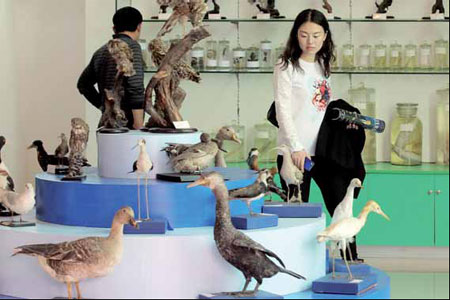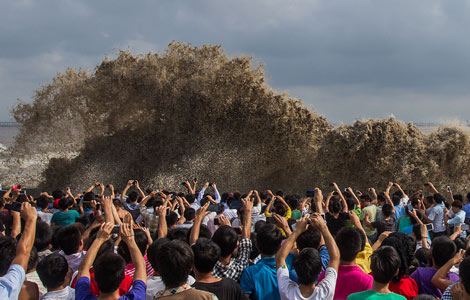On the right road back to nature
Updated: 2013-12-20 10:05
By Joseph Catanzaro and Tracey Barrett (China Daily Europe)
|
|||||||||||
Hunan gets its clean act together by balancing economic development with conservation
On the banks of Liuye Lake in Changde, where the morning mist hangs over water as clear as a looking glass, Ma Fengchi smiles at the world his generation made for their children. His 65-year-old son, Ma Jianshi, smiles with him.
"He has more than 60 descendants," the younger man says. "I always take him here for a walk."
The older Ma remembers a time in Changde when homes were made of bamboo, when men worked the soil or on the water to feed their families.
"I was a fisherman here, when I was young," he says. "Over my long life of 101 years, I never thought the country could develop so fast."
Forests of cranes now dominate the skylines of the cities that have sprung up in Ma's native Hunan province. Young people now work in factories, laboratories or in offices. The world has changed.
But on the banks of the lake, things remain much as they were in Ma's young days. In Hunan, where a man named Mao Zedong had also grown up.
"The secret (to my long life) is good feelings, and a good environment," Ma says. "The lake is very good."
The improving balance between a sustainable environment and booming industry is a relatively recent development in Ma's part of China. Not so long ago, much of the natural wonder of Hunan was in danger of being lost forever.
At a research center in the north of the province, in a room filled with wildlife stilled by death and taxidermy, Zhang Chen gestures to the corpse of a river dolphin preserved in a tank.
"Ten years ago there were 500," he says. "Now there are 100."
Zhang, a researcher with the Chinese Academy of Sciences, concedes much of Hunan's natural environment was threatened in the rush to modernize. Now, with government backing, conservationists are clawing back what was almost lost.
For the past 15 years, Zhang has worked at the 190,000-hectare East Dongting Lake Nature Reserve. Established in 1982 as part of the greater Dongting Lakes wetlands, it ranks among the 200 global biodiversity hotspots recognized by the World Wildlife Fund.
Now, protected by the government, the region is returning to life.
The area hosts a broad variety of species, including 338 of birds, 1,186 types of plant, 117 kinds of fish, two freshwater whales and 68 other forms of aquatic life. Some of the creatures that disappeared from the region are being prepared for their comeback; others have already arrived.
"We have developed a scheme to breed the river dolphins in protection," Zhang says.
Outside the research center, a young deer grazes.
"We reintroduced them from inland China," Zhang says. "We now have about 120 running wild."
Liu Huaide, director of the Hunan Two-Oriented Society general office, says the province has placed special emphasis on the protection of the environment. Government data indicates Hunan plans to invest a total of 60 billion yuan ($9.9 billion; 7.2 billion euros) in 10 major environmental projects, including treating pollution in rivers and lakes, improving air quality in major cities, building sewage and wastewater treatment facilities, improving the rural environment and promoting clean production.
From 2007 to 2012, about 1,200 projects with heavy pollution and high-energy consumption were shut down, leading to a 20.4 percent decrease in energy consumption per unit of GDP, according to figures provided by officials. A total of 264 polluting enterprises along the Xiangjiang River and 236 paper mills along Dongting Lake were closed. Last year, 86.5 percent of the sewage and 96.8 percent of solid waste in urban areas was treated. The nation's first carbon exchange opened in Hunan, and the environmental protection industry reported revenue of more than 70 billion yuan last year.
A mountain area of more than 520 square kilometers between the cities of Changsha, Zhuzhou and Xiangtan is the green heart of the city cluster, Liu says.
In 50 percent of that area, development is strictly forbidden, while another 39 percent is only available for restricted development.
Another ecological initiative in the pipeline is the construction of a scenic belt alongside Xiangjiang River, which, Liu says will become "a green economic corridor". It includes a 11.3 km stretch that meanders through Zuzhou, a resort park beside Liuye Lake in Changde, and a project in Yueyang that will include an international bicycle racing track.
In the middle of Xiangjing River that cuts through the provincial capital, Changsha, the world's largest inland island stands testament to the government's commitment to a greener future. Until about a decade ago, Orange Islet was home to a rundown residential area. Now, reclaimed and transformed into parklands, tourists and locals wander through wild orchards of fruit trees, or stop to have their photos taken in front of a giant stone bust of a 33-year-old Mao Zedong.
Despite the work that has been done, there are still challenges ahead, Zhang says. Finding a balance between economic and environmental sustainability is always a tightrope act.
"One problem is the contradiction between conservation and development," he says. "In China at present, the country is trying to develop more nature reserves to keep as much nature as possible. But it is difficult."
For Ma, these are hurdles for future generations to overcome. Right now, he treats the present like a gift. "I am happy," he says.
Zhang approaches a young deer, nursed back to health after it was discovered abandoned about 12 months ago.
"It was very small when we found it," he says. "Its nickname is Dian Dian. It means 'small baby'."
The battle to preserve Hunan's environment is still in its infancy and much work remains to be done. But one thing is certain. From little things, big things grow.
Contact the writers through josephcatanzaro@chinadaily.com.cn
|
Top: A patrol vessel in Dongting Lake Nature Reserve. Below: Specimens displayed at the work station of Dongting Lake Nature Reserve. Photos by Wang Jing / China Daily |

(China Daily European Weekly 12/20/2013 page22)
Today's Top News
Chinese merchant killed during robbery in Russia
IPR courts 'would be helpful'
Liaoning's combat capability tested
GM corn rejection not to hurt market
US aircraft hit by gunfire in South Sudan
Memorials mark Lockerbie attack
H5N2 outbreak confirmed in N China
China's moon rover works stably
Hot Topics
Lunar probe , China growth forecasts, Emission rules get tougher, China seen through 'colored lens', International board,
Editor's Picks

|

|

|

|

|

|






